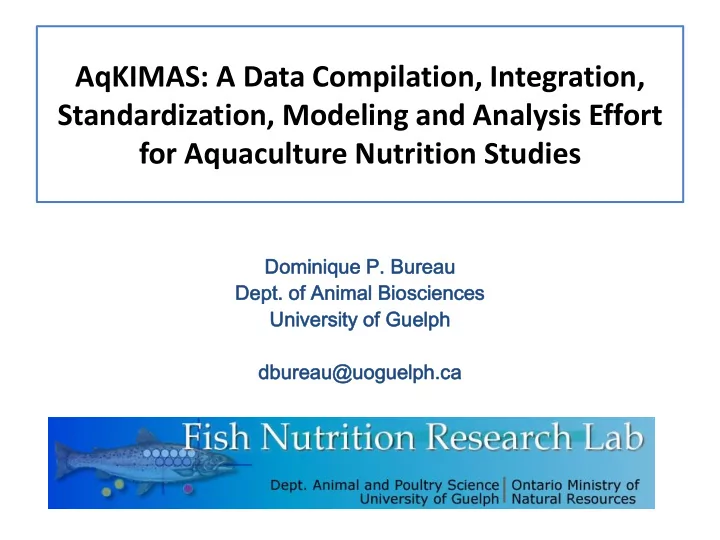

AqKIMAS: A Data Compilation, Integration, Standardization, Modeling and Analysis Effort for Aquaculture Nutrition Studies Dominique minique P. Bu Bure reau au Dept pt. of Animal mal Biosciences sciences Unive iversity sity of G Guel elph ph dbureau ureau@u @uog oguelph uelph.ca .ca
Aquaculture nutrition: a very dynamic research field > 1000s studies on nutrient requirements of fish and crustaceans > 300 scientific papers and technical documents on essential amino acid requirements > 500 studies or papers on the nutritive value of soybean products (soybean meal, oil, protein concentrates) > 500 papers on nutritive value of animal proteins and fats for aquatic species > 500 documents on “fish meal and fish oil replacement" over the past two or three decades. Interest in the field, effort invested, talent pool, and money are not lacking and these represent terrific resources/driving forces.
NRC Committee of Nutrient Requirements of Fish and Shrimp (2009-2011) NRC 2011 Review of state-of-the-art Committee reviewed 1000s of papers Imperfect document and recommendations represent best effort
Meta-Analysis of Essential Amino Acid Requirements of Fish Total Main causes of 286 studies rejection: 1) Key piece(s) of information missing in Relevant paper and preventing 249 calculation of parameter(s) deemed important 2) Insufficient graded EAA levels (or inappropriate Suitable design for goal of meta- analysis) 109 3) Poor growth or feed 22 fish species efficiency achieved in study
AQUACULTURE = Diversity of Species >340 SPECIES 3 67 212 42 15 Slide courtesy of Dr. A.J. Tacon
Current Challenges: Developing Nutritional Specifications for Different Species, Life Stages, Weight Ranges and Feed Types Predicting the content in bio-available nutrients in diets composed of an increasing wide variety of feed ingredients
Challenge: Meeting the nutrient requirements of a diversity of species ranging greatly in weight, fed diets formulated with a wide variety of feed ingredients. Number of combinations/permutations too great to study experimentally. How can we derive the estimates we need from the literature? It is not sufficient to know different factors have effects. You also need to be able to quantify the combined effects of these different factors
Example: Dietary Phosphorus Digestibility No trend for meaningful No effect of P level on P digestibility dietary range 100 P apprarent digestibility (%) 80 60 Decreasing P digestibility with 40 increasing total P level 20 0 0 10 20 30 40 Dietary P (g/kg) Dataset: 137 treatments from 22 studies with rainbow trout
We often have everything we need – the issue is finding it! No need to reinvent the wheel
The answer is organizing the information at hand in a sensible way! Systematic integration of data and mathematical modelling to analyze this information can be a very effective way of achieving this. Before After
Knowledge Translation and Transfer (KTT) Efforts by UG/OMNR Fish Nutrition Research Laboratory Models (bioenergetics, nutrient-flow, mechanistic) for estimating feed requirement, FCR, and waste outputs of fish culture operations (e.g. Cho, 1992, Cho & Bureau, 1998, Bureau et al., 2003; Azevedo et al., 2011) Models of phosphorus, lipids and starch digestibility for different fish species (e.g. Hua and Bureau, 2006, 2009a&b, 2010) Modeling growth trajectory, body composition and nutrient deposition (e.g. Dumas et al., 2007a&b) Meta-analysis of studies on fish meal replacement by plant protein ingredients (e.g. Hua and Bureau, submitted for publication) Meta-analysis of essential amino acids requirements of teleost fish (e.g. Salze et al., 2011) Factorial models of nutrient requirements (e.g. Tables 5-20 & 5-21 in NRC (2011) Nutrient Requirements of Fish and Shrimp) Asian Aquaculture Feed Formulation Database These efforts all involved gathering, compiling, auditing (verifying), integrating and analyzing data from wide variety of sources
FISH MEAL REPLACEMENT BY PLANT PROTEIN INGREDIENTS IN SALMONID FEEDS: TOWARD A META-ANALYSIS OF PUBLISHED STUDIES TAKING INTO ACCOUNT NUTRITIONAL ADEQUACY, GROWTH PERFORMANCE, AND NUTRIENT UTILIZATION Katheline Hua and Dominique P Bureau Sponsored by:
Traditional Approach for Analysis of Data from Trials Raw Independent Variable Data Raw Dependent Variable Data Simple Inferential Statistics (within study) Conclusion
Example: Response of Fish to Increasing Levels of a Plant Protein Ingredient (e.g. SBM) Replacing Fish Meal in the Diet of Rainbow Trout 110 No effect 100 Response (% of control) Reduced * performance 90 ** attributable to what? Significant reduction 80 *** Nutritional 70 deficiencies? 60 Other limitations? 50 40 0 10 20 30 40 50 Incorporation Level (%)
Recommend
More recommend